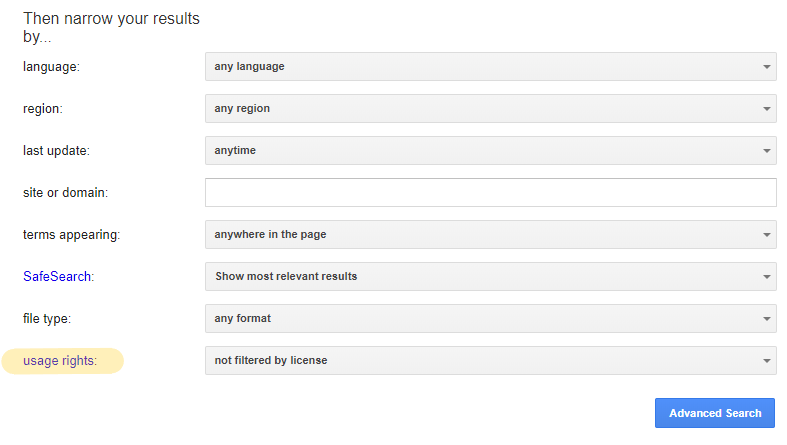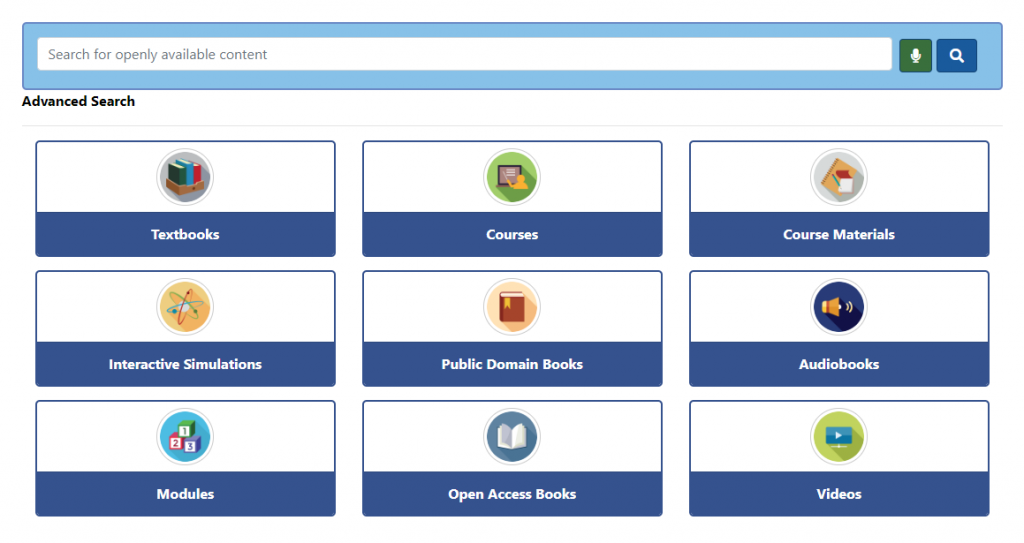Learning Objectives
By the end of this section, you will be able to:
- Demonstrate how to conduct a preliminary search for open educational resources.
- List three resources that can be used for finding OER.
There are many different places used to host OER, from institutional repositories to grant-funded websites. Consequently, not all OER are easy to find. In this chapter, we will review some methods you can use to locate OER for your course.
https://youtube.com/watch?v=FbwuMQM-NG8%3Fstart%3D7%26feature%3Doembed
Attribution: “How to Find and Evaluate OER” by Abbey Elder is licensed under a CC BY 4.0 International license.
THE SEARCH PROCESS
There are four easy steps any instructor can take when looking for open content:
- Identify keywords related to your course and its learning objectives.
- Search OER repositories and aggregators for any relevant resources.
- Review the resources you’ve located for fit, currency, accessibility, and any other rubric you deem necessary when judging teaching materials.
- Reflect on the materials you have located.
For a more guided approach through this process, download a copy of our OER Treasure Hunt Worksheet in Google Docs.
SEARCH TIPS
Start Broad
Searching for OER can be difficult when you’re starting from a narrow perspective. For the most results, start with a broad search focused on your discipline. Once you’ve brought together a large collection of resources, then you can begin to limit your results.
OER Search Scenario
Barbara teaches a course on abnormal psychology. She wants to find videos, readings, and case studies related to this topic for her course. Here is an example of a search strategy she can follow by starting broad:
- Search the Open Textbook Library for “Psychology.” Peruse the Tables of Contents of listed textbooks to find chapters or sections focusing on topics covered in the course.
- Search OASIS for “abnormal psychology.” Since OASIS searches content on multiple repositories, limiting your search a little more can be useful. These can then be sorted by format, type, or date.
- Search YouTube for videos on specific topics related to Abnormal Psych. Since YouTube contains so many different types of content, being specific is more important on this platform.
- As a last-ditch effort, do an Advanced Search in Google for “Abnormal Psychology” (we will discuss this more below).
By the end of these searches, Barbara has compiled the following list: Abnormal Psychology OER List in Google Docs
Check Your Understanding
Try out your own search using simple keywords. What did you find from your initial search? When did you decide to start narrowing your results? What’s missing?
Keep an Open Mind
You don’t have to jump into a fully open course right away. Start small by adding OER lesson plans to your coursework, or wait and see what OER are published next semester. The number and breadth of OER available are changing every day. Although there might not be resources available for your course right now, that may not be the case next year or even next month. Including OER in your regular assessment of materials for use in your course is a great first step for finding resources you can adopt in the future.
Filter by Usage Rights in Google
Google is a familiar resource for many of us, and it is also useful for finding openly licensed content. The Advanced Search feature in Google allows you to filter results by Usage rights. Filtering by usage rights will limit your results to works with certain licenses listed on the webpage, usually Creative Commons licenses. There are a few options to choose from in the Usage Rights list, but we recommend starting with “free to use or share” to retrieve the broadest set of results.[1]

Remember when using this method that Google trusts what users tell it about an item’s copyright status. Although a resource may be labeled CC BY or even CC 0, you should trust your instincts if you aren’t sure whether the item you are reviewing is actually under copyright. Contact a librarian or a university lawyer if you have questions.
This chapter has provided a short overview of some tools and techniques you can use to find OER. In the next chapter, we’ll provide a more comprehensive list of search tools grouped by topic and type.
REPOSITORIES AND SEARCH TOOLS
Learning Objectives
By the end of this section, you will be able to:
- Identify four search tools for finding open educational resources.
- Identify at least two search tools for finding openly licensed media.
In the last chapter, we reviewed some strategies for finding OER. Below, a set of available repositories, search tools, and resources are listed to help you find the right OER for you.
BEST BETS
When starting your search for OER, it’s best to begin in a place with a wide variety of options. The websites listed below each have a different focus, but they are good places to start if you aren’t sure what to look for.
- The Open Textbook Library is a great resource for finding open textbooks. If you want a textbook and nothing more, this is the place to start.
- BCCampus Open Textbooks collects resources created, reviewed, or adopted by instructors at British Columbia universities. Materials can be filtered by Accessibility as well as whether they have been adopted by BCCampus courses, include ancillary materials, or have been reviewed by faculty.
- Curated lists of OER, like the Iowa State University Library Guide to OER, can be useful for exploring a selection of open content in your subject area.
FEDERATED SEARCH TOOLS

SUNY’s Openly Available Sources Integrated Search (OASIS)
OASIS is a search tool that aims to make the discovery of open content easier by searching multiple sources for OER and other open content at once. OASIS currently searches for open content from 79 different sources and contains approximately 330,000 records.
The Mason OER Metafinder (MOM) links to a wide array of open content, including open access books and articles, documents in the public domain, and OER. Because of its large breadth of resources, we recommend that you start your MOM search with only a selection of the “OER-specific sites” checked, rather than all the materials it can include.
MERLOT is a project that was started in 1997 by the California State University system. The repository includes thousands of resources contributed by members, including original content and links to resources found through other platforms.
INSTITUTIONAL COLLECTIONS
Institutional repositories (IRs) aren’t just for sharing copies of research articles and student theses. They can also be used to store and share OER. Although not every college shares OER through their institutional repository, the colleges below do share collections of OER specific to their institution:
- Galileo Open Learning Materials (Georgia higher ed institutions)
- OpenMichigan (University of Michigan)
- MIT OpenCourseWare (Massachusetts Institute of Technology)
SUBJECT-SPECIFIC REPOSITORIES
Some open educational resources are shared through subject-specific repositories. A few notable examples of this type, including open publishers that specialize in one discipline, are listed below:
- Chem Collective: Chemistry
- Learn Chem E: Chemical Engineering
- Noba Project Psychology Modules: Psychology
- Center for Open Educational Resources and Language Learning (COERLL): Languages
- Open Geography Education: Geography
- Engineering Technology Simulations: Engineering, Physics
- PhET Simulations: Physics, Physical science, Geology, Chemistry
- SkillsCommons: Career & Technical Education (CTE)
- Green Tea Press Textbooks: Computer Science, Programming (Bayes, Python, MATLAB, Java, DSP)
OER BY COURSE
Some colleges choose to share information about which OER their instructors assign in courses. These lists can give you a good idea of what other instructors in your discipline have adopted and (if they have provided a review), what they think of their adopted resource.
- COOL4ED Faculty Showcase (California universities and colleges)
- Open Oregon Educational Resources (Oregon universities and colleges)
- OPEN NYS Faculty Assessments (New York State universities)
OPEN CONTENT (NOT EXPLICITLY OER)
Not all open content is made to be used in the classroom, but that doesn’t mean you can’t integrate them into your course. Open access book chapters and openly-licensed media can be great additions to your course.
Open Access Publishers and Repositories
- Directory of Open Access Journals (DOAJ): Open Access journal articles
- Directory of Open Access Books (DOAB): Open Access books
- Project Gutenberg: Public domain books and documents
- PubMed: Open access journal articles
- Public Library of Science (PLoS): Open access journal publisher
- Open Book Publishers: Open access book publisher
CC-licensed Media
- CC Search: A federated search tool for finding content available under a CC license
- Digital Public Library of America: Public domain images, videos, recordings, and texts
- The Metropolitan Museum of Art: High-quality open images from the Met
- Pexels: Public domain and CC-licensed photographs and stock images
- Unsplash: Public domain and CC-licensed photographs and stock images
- Wikimedia Commons: Public domain and CC-licensed images and figures
- Google Image Search: Images. Use the Tools/Usage rights button to filter by license
- Youtube: Videos. Use the Advanced Search/CC license option to see open content
- Free Music Archive: Public domain and CC-licensed music and sound bytes
GETTING HELP
- Adding “OER” to your search terms can help you locate materials created for sharing if your Google search is retrieving too many results. ↵
Attribution: “The OER Starter Kit” by Abbey Elder is licensed under CC BY 4.0
